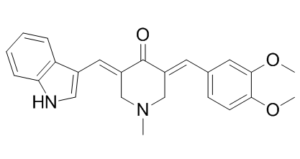CA-5f (CA5f) is a novel and potent late-stage macroautophagy/autophagy inhibitor via inhibiting autophagosome-lysosome fusion with anti-tumor activity. It has potent anti-tumor effect against non-small cell lung cancer. CA-5f neither impaired the hydrolytic function nor the quantity of lysosomes. Use of an isobaric tag for relative and absolute quantitation (iTRAQ)-based proteomic screen in combination with bioinformatics analysis suggested that treatment of human umbilical vein endothelial cells (HUVECs) with CA-5f for 1 h suppressed the levels of cytoskeletal proteins and membrane traffic proteins. Subsequent studies showed that CA-5f exhibited strong cytotoxicity against A549 non-small cell lung cancer (NSCLC) cells, but low cytotoxicity to normal human umbilical vein endothelial cells (HUVECs), by increasing mitochondrial-derived reactive oxygen species (ROS) production.
Physicochemical Properties
| Molecular Formula | C24H24N2O3 | |
| Molecular Weight | 388.46 | |
| Exact Mass | 388.178 | |
| CAS # | 1370032-19-1 | |
| Related CAS # |
|
|
| PubChem CID | 57341148 | |
| Appearance | Light yellow to yellow solid powder | |
| LogP | 3.7 | |
| Hydrogen Bond Donor Count | 1 | |
| Hydrogen Bond Acceptor Count | 4 | |
| Rotatable Bond Count | 4 | |
| Heavy Atom Count | 29 | |
| Complexity | 659 | |
| Defined Atom Stereocenter Count | 0 | |
| SMILES | C(/C1=CNC2=CC=CC=C12)=C1\C(/C(/CN(C)C\1)=C/C1C=CC(OC)=C(OC)C=1)=O |
|
| InChi Key | JYOLPDWVAMBMQN-UBIAKTOFSA-N | |
| InChi Code | InChI=1S/C24H24N2O3/c1-26-14-18(10-16-8-9-22(28-2)23(11-16)29-3)24(27)19(15-26)12-17-13-25-21-7-5-4-6-20(17)21/h4-13,25H,14-15H2,1-3H3/b18-10+,19-12+ | |
| Chemical Name |
|
|
| Synonyms |
|
|
| HS Tariff Code | 2934.99.9001 | |
| Storage |
Powder-20°C 3 years 4°C 2 years In solvent -80°C 6 months -20°C 1 month |
|
| Shipping Condition | Room temperature (This product is stable at ambient temperature for a few days during ordinary shipping and time spent in Customs) |
Biological Activity
| Targets |
|
|
| ln Vitro | In A549 cells and HUVEC, CA-5f (0-40 μM, 6 hours) elevates the levels of SQSTM1 protein and LC3B-II (an autophagy monitoring marker) in a concentration- and time-dependent manner [1]. A549 cells and HUVECs treated with CA-5f (20 μM, 6 hours) or in combination with Bafilomycin A1 (100 nM) or Chloroquine (30 μM) do not exhibit autophagosome degradation [1]. Neither the number of lysosomes nor the hydrolytic function are impacted by CA-5f (20 μM) [1]. CA-5f (20 μM, 96 hours) is less harmful to normal HUVECs and suppresses the development of A549 cells [1]. | |
| ln Vivo | In nude mice containing A549 lung cancer cells, CA-5f (40 mg/kg, intraperitoneal injection, once every two days, up to 30 days) is well tolerated and can successfully stop tumor growth [1]. Using A549 lung cancer cells, CA-5f (40 mg/kg, ip) suppresses autophagy flux and causes apoptosis in nude mice [1]. | |
| Cell Assay |
Cell Viability Assay[1] Cell Types: A549, HUVECs Tested Concentrations: 20 μM Incubation Duration: 96 hrs (hours) Experimental Results: demonstrated more cytotoxicity against A549 cells compared with normal HUVECs. Western Blot Analysis[1] Cell Types: A549 cells and HUVECs Tested Concentrations: 0 -40 μM Incubation Duration: 6 hrs (hours) Experimental Results: Elevated LC3B-II (a marker to monitor autophagy) and SQSTM1 protein levels in a concentration- and time-dependent manner. |
|
| Animal Protocol |
Animal/Disease Models: Nude mice bearing A549 lung cancer cells[1] Doses: 40 mg/kg Route of Administration: Injected via caudal vein, every 2 days for up to 30 days Experimental Results: Dramatically suppressed tumor volume and weight in mice, increased the number of apoptotic cells in mice. |
|
| References |
[1]. Identification of compound CA-5f as a novel late-stage autophagy inhibitor with potent anti-tumor effect against non-small cell lung cancer. Autophagy. 2019 Mar;15(3):391-406. |
Solubility Data
| Solubility (In Vitro) |
|
|||
| Solubility (In Vivo) |
Solubility in Formulation 1: ≥ 2.08 mg/mL (5.35 mM) (saturation unknown) in 10% DMSO + 40% PEG300 + 5% Tween80 + 45% Saline (add these co-solvents sequentially from left to right, and one by one), clear solution. For example, if 1 mL of working solution is to be prepared, you can add 100 μL of 20.8 mg/mL clear DMSO stock solution to 400 μL PEG300 and mix evenly; then add 50 μL Tween-80 to the above solution and mix evenly; then add 450 μL normal saline to adjust the volume to 1 mL. Preparation of saline: Dissolve 0.9 g of sodium chloride in 100 mL ddH₂ O to obtain a clear solution. Solubility in Formulation 2: 2.08 mg/mL (5.35 mM) in 10% DMSO + 90% (20% SBE-β-CD in Saline) (add these co-solvents sequentially from left to right, and one by one), suspension solution; with ultrasonication. For example, if 1 mL of working solution is to be prepared, you can add 100 μL of 20.8 mg/mL clear DMSO stock solution to 900 μL of 20% SBE-β-CD physiological saline solution and mix evenly. Preparation of 20% SBE-β-CD in Saline (4°C,1 week): Dissolve 2 g SBE-β-CD in 10 mL saline to obtain a clear solution. Solubility in Formulation 3: ≥ 2.08 mg/mL (5.35 mM) (saturation unknown) in 10% DMSO + 90% Corn Oil (add these co-solvents sequentially from left to right, and one by one), clear solution. For example, if 1 mL of working solution is to be prepared, you can add 100 μL of 20.8 mg/mL clear DMSO stock solution to 900 μL of corn oil and mix evenly. (Please use freshly prepared in vivo formulations for optimal results.) |
| Preparing Stock Solutions | 1 mg | 5 mg | 10 mg | |
| 1 mM | 2.5743 mL | 12.8713 mL | 25.7427 mL | |
| 5 mM | 0.5149 mL | 2.5743 mL | 5.1485 mL | |
| 10 mM | 0.2574 mL | 1.2871 mL | 2.5743 mL |
